The Influence of Online and Offline Communication in the Modern Era
VerifiedAdded on 2023/01/16
|8
|2248
|49
Essay
AI Summary
This essay delves into the multifaceted realm of online and offline communication, meticulously examining their distinct characteristics and profound impacts on user behavior and societal dynamics. The essay begins by defining social influence and its role in shaping individual actions, then contrasts the traditional, offline modes of communication with the modern, technology-driven online methods. It explores how social media platforms have reshaped communication patterns, influencing both online and offline user engagement, and investigates the benefits and drawbacks of each communication type. The essay references a study analyzing millions of online and offline actions to illustrate the effects of social networking on user retention and engagement. It also explores the negative consequences of excessive social media use, such as addiction, cyberbullying, and unrealistic expectations, while also acknowledging the benefits of online communication, such as flexibility and global connectivity. The essay concludes by highlighting the ongoing debate about the advantages and disadvantages of each communication method, emphasizing the need for a balanced approach to leverage the benefits of both online and offline interactions effectively.
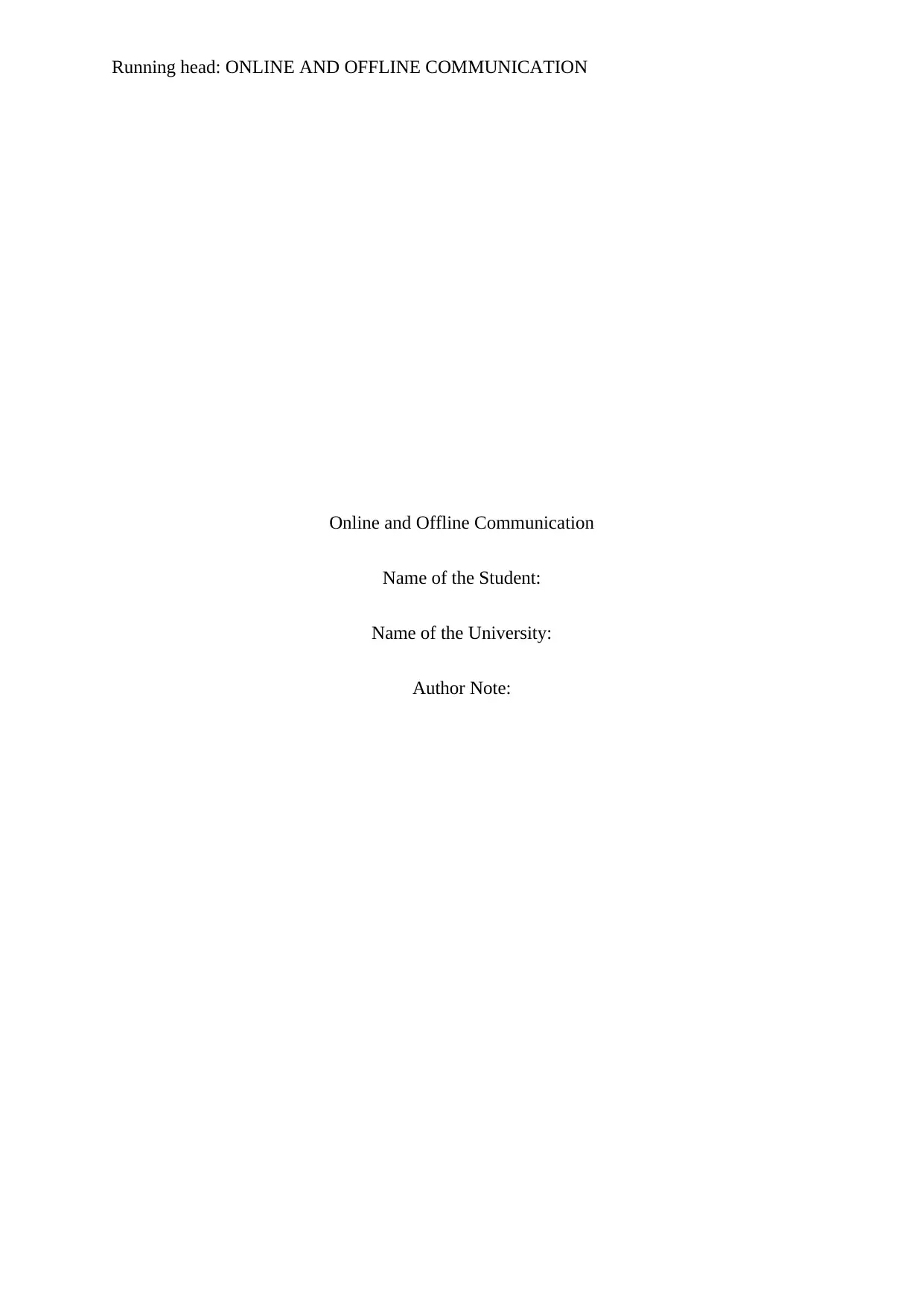
Running head: ONLINE AND OFFLINE COMMUNICATION
Online and Offline Communication
Name of the Student:
Name of the University:
Author Note:
Online and Offline Communication
Name of the Student:
Name of the University:
Author Note:
Paraphrase This Document
Need a fresh take? Get an instant paraphrase of this document with our AI Paraphraser
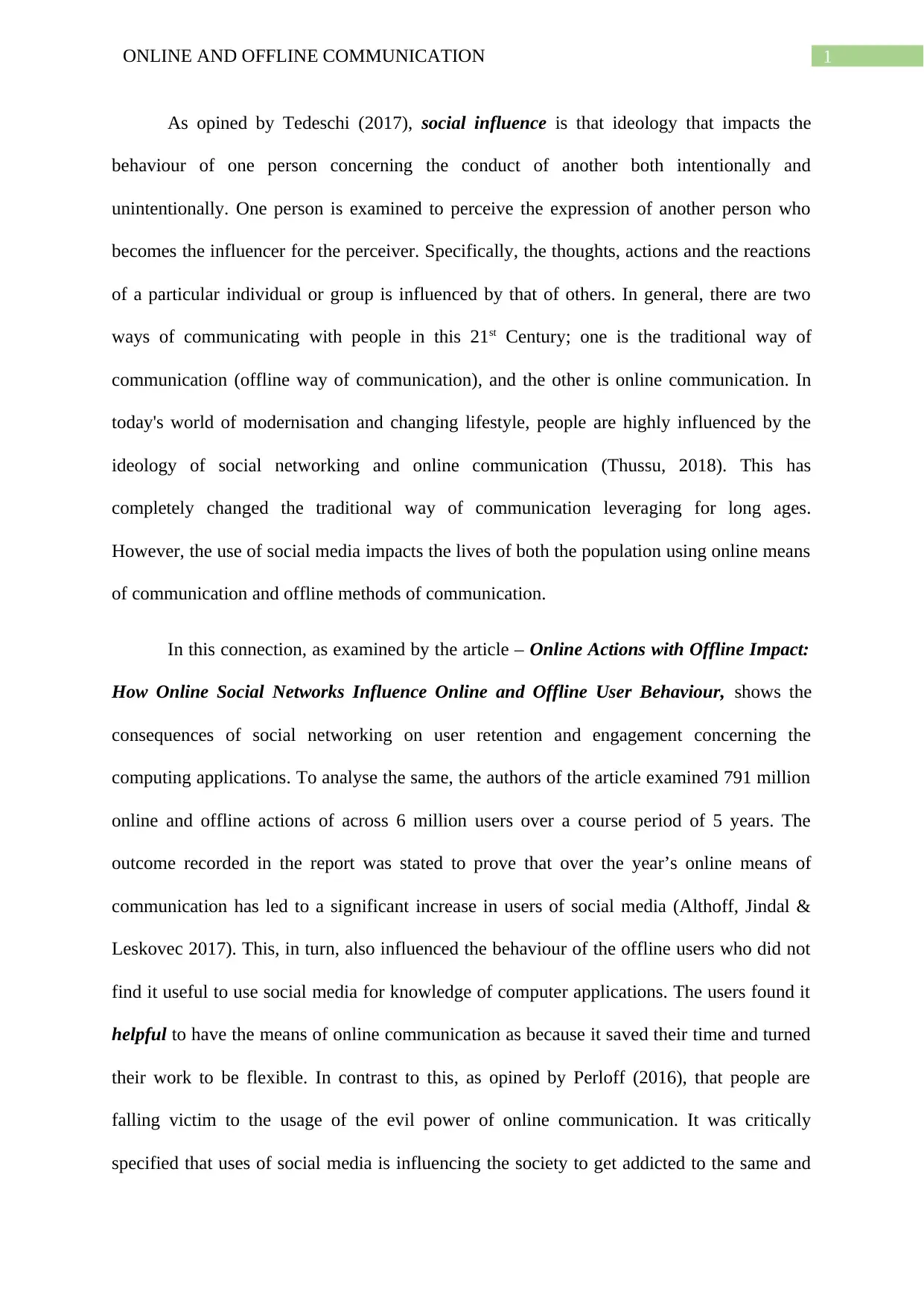
1ONLINE AND OFFLINE COMMUNICATION
As opined by Tedeschi (2017), social influence is that ideology that impacts the
behaviour of one person concerning the conduct of another both intentionally and
unintentionally. One person is examined to perceive the expression of another person who
becomes the influencer for the perceiver. Specifically, the thoughts, actions and the reactions
of a particular individual or group is influenced by that of others. In general, there are two
ways of communicating with people in this 21st Century; one is the traditional way of
communication (offline way of communication), and the other is online communication. In
today's world of modernisation and changing lifestyle, people are highly influenced by the
ideology of social networking and online communication (Thussu, 2018). This has
completely changed the traditional way of communication leveraging for long ages.
However, the use of social media impacts the lives of both the population using online means
of communication and offline methods of communication.
In this connection, as examined by the article – Online Actions with Offline Impact:
How Online Social Networks Influence Online and Offline User Behaviour, shows the
consequences of social networking on user retention and engagement concerning the
computing applications. To analyse the same, the authors of the article examined 791 million
online and offline actions of across 6 million users over a course period of 5 years. The
outcome recorded in the report was stated to prove that over the year’s online means of
communication has led to a significant increase in users of social media (Althoff, Jindal &
Leskovec 2017). This, in turn, also influenced the behaviour of the offline users who did not
find it useful to use social media for knowledge of computer applications. The users found it
helpful to have the means of online communication as because it saved their time and turned
their work to be flexible. In contrast to this, as opined by Perloff (2016), that people are
falling victim to the usage of the evil power of online communication. It was critically
specified that uses of social media is influencing the society to get addicted to the same and
As opined by Tedeschi (2017), social influence is that ideology that impacts the
behaviour of one person concerning the conduct of another both intentionally and
unintentionally. One person is examined to perceive the expression of another person who
becomes the influencer for the perceiver. Specifically, the thoughts, actions and the reactions
of a particular individual or group is influenced by that of others. In general, there are two
ways of communicating with people in this 21st Century; one is the traditional way of
communication (offline way of communication), and the other is online communication. In
today's world of modernisation and changing lifestyle, people are highly influenced by the
ideology of social networking and online communication (Thussu, 2018). This has
completely changed the traditional way of communication leveraging for long ages.
However, the use of social media impacts the lives of both the population using online means
of communication and offline methods of communication.
In this connection, as examined by the article – Online Actions with Offline Impact:
How Online Social Networks Influence Online and Offline User Behaviour, shows the
consequences of social networking on user retention and engagement concerning the
computing applications. To analyse the same, the authors of the article examined 791 million
online and offline actions of across 6 million users over a course period of 5 years. The
outcome recorded in the report was stated to prove that over the year’s online means of
communication has led to a significant increase in users of social media (Althoff, Jindal &
Leskovec 2017). This, in turn, also influenced the behaviour of the offline users who did not
find it useful to use social media for knowledge of computer applications. The users found it
helpful to have the means of online communication as because it saved their time and turned
their work to be flexible. In contrast to this, as opined by Perloff (2016), that people are
falling victim to the usage of the evil power of online communication. It was critically
specified that uses of social media is influencing the society to get addicted to the same and
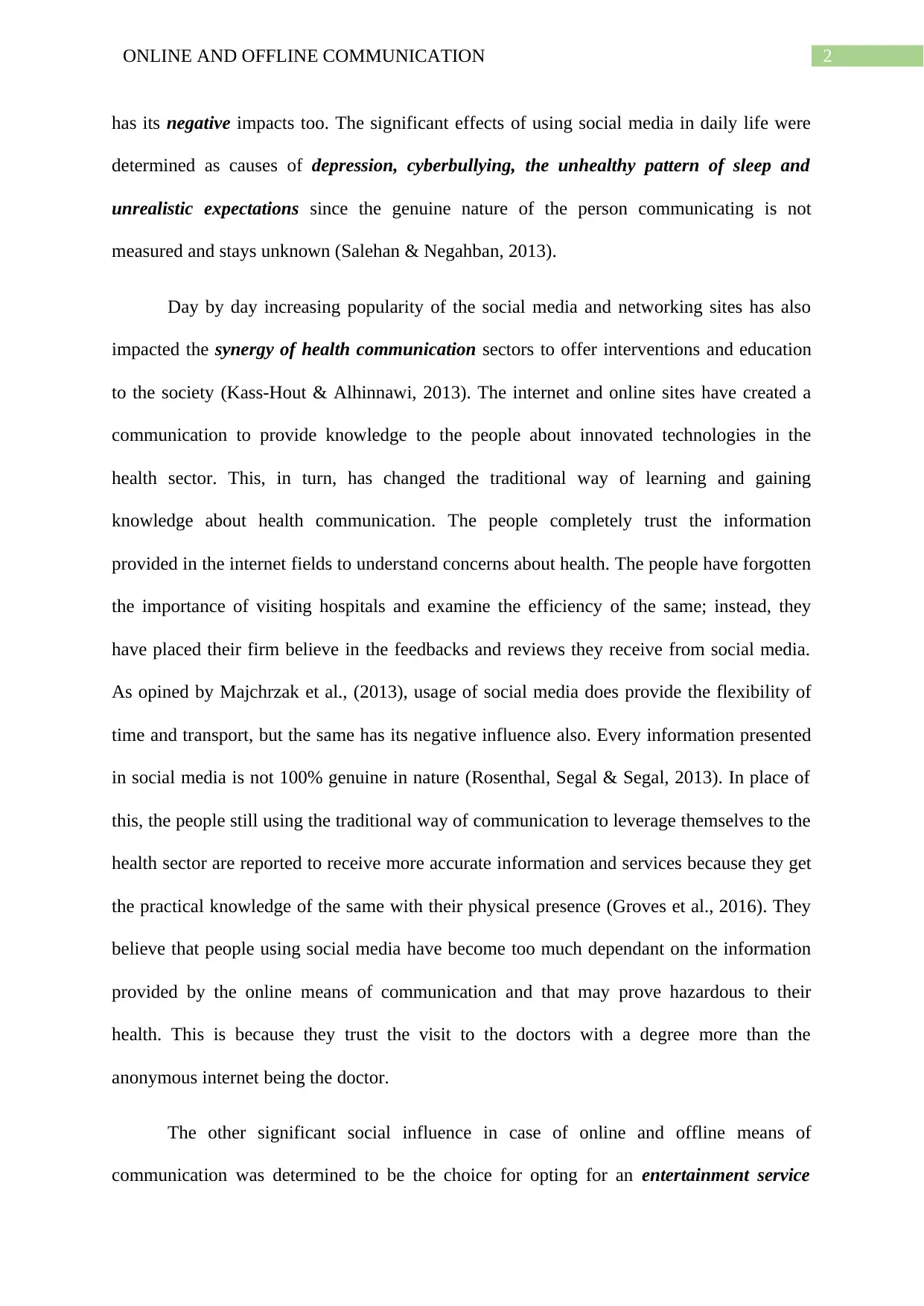
2ONLINE AND OFFLINE COMMUNICATION
has its negative impacts too. The significant effects of using social media in daily life were
determined as causes of depression, cyberbullying, the unhealthy pattern of sleep and
unrealistic expectations since the genuine nature of the person communicating is not
measured and stays unknown (Salehan & Negahban, 2013).
Day by day increasing popularity of the social media and networking sites has also
impacted the synergy of health communication sectors to offer interventions and education
to the society (Kass-Hout & Alhinnawi, 2013). The internet and online sites have created a
communication to provide knowledge to the people about innovated technologies in the
health sector. This, in turn, has changed the traditional way of learning and gaining
knowledge about health communication. The people completely trust the information
provided in the internet fields to understand concerns about health. The people have forgotten
the importance of visiting hospitals and examine the efficiency of the same; instead, they
have placed their firm believe in the feedbacks and reviews they receive from social media.
As opined by Majchrzak et al., (2013), usage of social media does provide the flexibility of
time and transport, but the same has its negative influence also. Every information presented
in social media is not 100% genuine in nature (Rosenthal, Segal & Segal, 2013). In place of
this, the people still using the traditional way of communication to leverage themselves to the
health sector are reported to receive more accurate information and services because they get
the practical knowledge of the same with their physical presence (Groves et al., 2016). They
believe that people using social media have become too much dependant on the information
provided by the online means of communication and that may prove hazardous to their
health. This is because they trust the visit to the doctors with a degree more than the
anonymous internet being the doctor.
The other significant social influence in case of online and offline means of
communication was determined to be the choice for opting for an entertainment service
has its negative impacts too. The significant effects of using social media in daily life were
determined as causes of depression, cyberbullying, the unhealthy pattern of sleep and
unrealistic expectations since the genuine nature of the person communicating is not
measured and stays unknown (Salehan & Negahban, 2013).
Day by day increasing popularity of the social media and networking sites has also
impacted the synergy of health communication sectors to offer interventions and education
to the society (Kass-Hout & Alhinnawi, 2013). The internet and online sites have created a
communication to provide knowledge to the people about innovated technologies in the
health sector. This, in turn, has changed the traditional way of learning and gaining
knowledge about health communication. The people completely trust the information
provided in the internet fields to understand concerns about health. The people have forgotten
the importance of visiting hospitals and examine the efficiency of the same; instead, they
have placed their firm believe in the feedbacks and reviews they receive from social media.
As opined by Majchrzak et al., (2013), usage of social media does provide the flexibility of
time and transport, but the same has its negative influence also. Every information presented
in social media is not 100% genuine in nature (Rosenthal, Segal & Segal, 2013). In place of
this, the people still using the traditional way of communication to leverage themselves to the
health sector are reported to receive more accurate information and services because they get
the practical knowledge of the same with their physical presence (Groves et al., 2016). They
believe that people using social media have become too much dependant on the information
provided by the online means of communication and that may prove hazardous to their
health. This is because they trust the visit to the doctors with a degree more than the
anonymous internet being the doctor.
The other significant social influence in case of online and offline means of
communication was determined to be the choice for opting for an entertainment service
⊘ This is a preview!⊘
Do you want full access?
Subscribe today to unlock all pages.

Trusted by 1+ million students worldwide
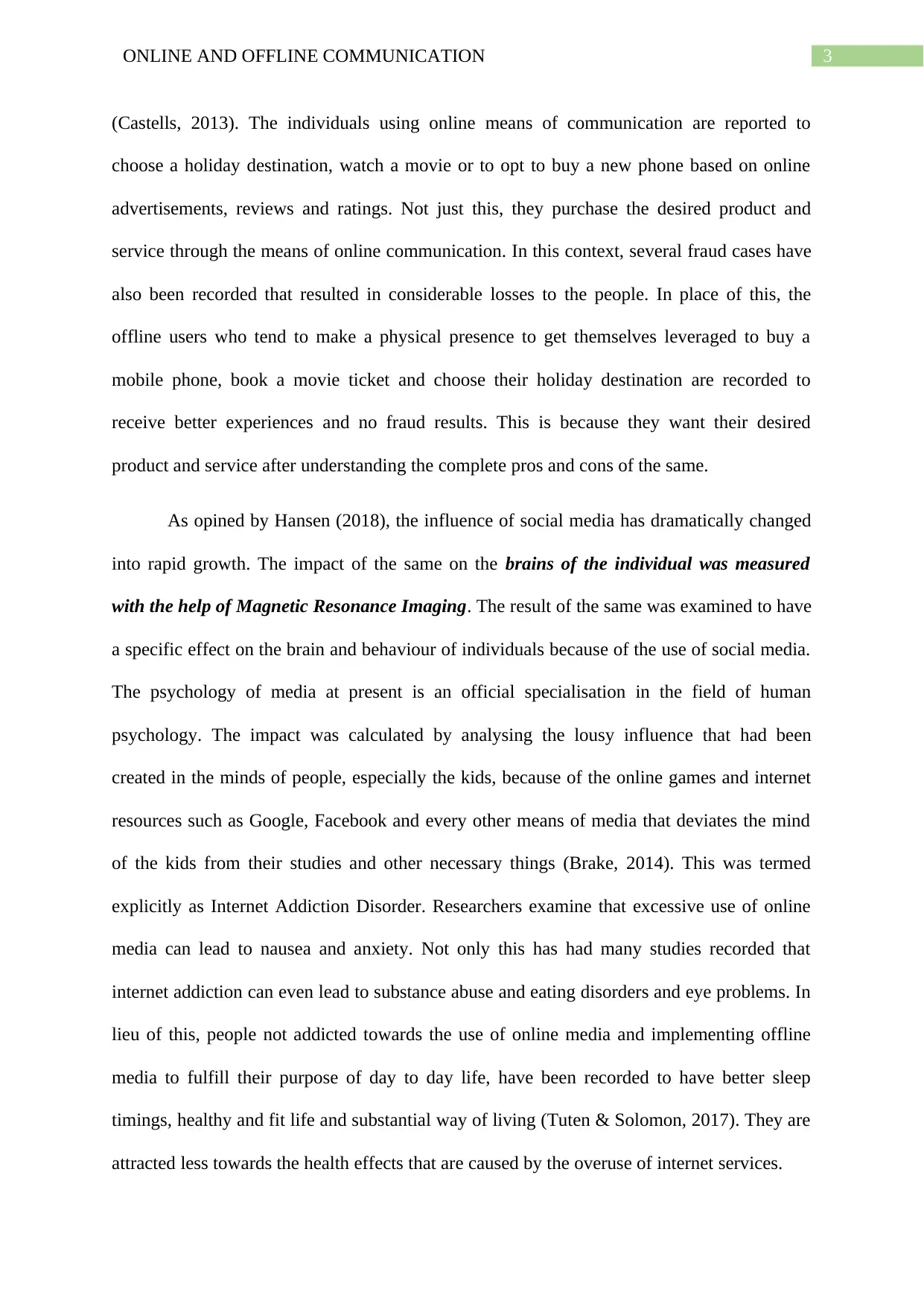
3ONLINE AND OFFLINE COMMUNICATION
(Castells, 2013). The individuals using online means of communication are reported to
choose a holiday destination, watch a movie or to opt to buy a new phone based on online
advertisements, reviews and ratings. Not just this, they purchase the desired product and
service through the means of online communication. In this context, several fraud cases have
also been recorded that resulted in considerable losses to the people. In place of this, the
offline users who tend to make a physical presence to get themselves leveraged to buy a
mobile phone, book a movie ticket and choose their holiday destination are recorded to
receive better experiences and no fraud results. This is because they want their desired
product and service after understanding the complete pros and cons of the same.
As opined by Hansen (2018), the influence of social media has dramatically changed
into rapid growth. The impact of the same on the brains of the individual was measured
with the help of Magnetic Resonance Imaging. The result of the same was examined to have
a specific effect on the brain and behaviour of individuals because of the use of social media.
The psychology of media at present is an official specialisation in the field of human
psychology. The impact was calculated by analysing the lousy influence that had been
created in the minds of people, especially the kids, because of the online games and internet
resources such as Google, Facebook and every other means of media that deviates the mind
of the kids from their studies and other necessary things (Brake, 2014). This was termed
explicitly as Internet Addiction Disorder. Researchers examine that excessive use of online
media can lead to nausea and anxiety. Not only this has had many studies recorded that
internet addiction can even lead to substance abuse and eating disorders and eye problems. In
lieu of this, people not addicted towards the use of online media and implementing offline
media to fulfill their purpose of day to day life, have been recorded to have better sleep
timings, healthy and fit life and substantial way of living (Tuten & Solomon, 2017). They are
attracted less towards the health effects that are caused by the overuse of internet services.
(Castells, 2013). The individuals using online means of communication are reported to
choose a holiday destination, watch a movie or to opt to buy a new phone based on online
advertisements, reviews and ratings. Not just this, they purchase the desired product and
service through the means of online communication. In this context, several fraud cases have
also been recorded that resulted in considerable losses to the people. In place of this, the
offline users who tend to make a physical presence to get themselves leveraged to buy a
mobile phone, book a movie ticket and choose their holiday destination are recorded to
receive better experiences and no fraud results. This is because they want their desired
product and service after understanding the complete pros and cons of the same.
As opined by Hansen (2018), the influence of social media has dramatically changed
into rapid growth. The impact of the same on the brains of the individual was measured
with the help of Magnetic Resonance Imaging. The result of the same was examined to have
a specific effect on the brain and behaviour of individuals because of the use of social media.
The psychology of media at present is an official specialisation in the field of human
psychology. The impact was calculated by analysing the lousy influence that had been
created in the minds of people, especially the kids, because of the online games and internet
resources such as Google, Facebook and every other means of media that deviates the mind
of the kids from their studies and other necessary things (Brake, 2014). This was termed
explicitly as Internet Addiction Disorder. Researchers examine that excessive use of online
media can lead to nausea and anxiety. Not only this has had many studies recorded that
internet addiction can even lead to substance abuse and eating disorders and eye problems. In
lieu of this, people not addicted towards the use of online media and implementing offline
media to fulfill their purpose of day to day life, have been recorded to have better sleep
timings, healthy and fit life and substantial way of living (Tuten & Solomon, 2017). They are
attracted less towards the health effects that are caused by the overuse of internet services.
Paraphrase This Document
Need a fresh take? Get an instant paraphrase of this document with our AI Paraphraser
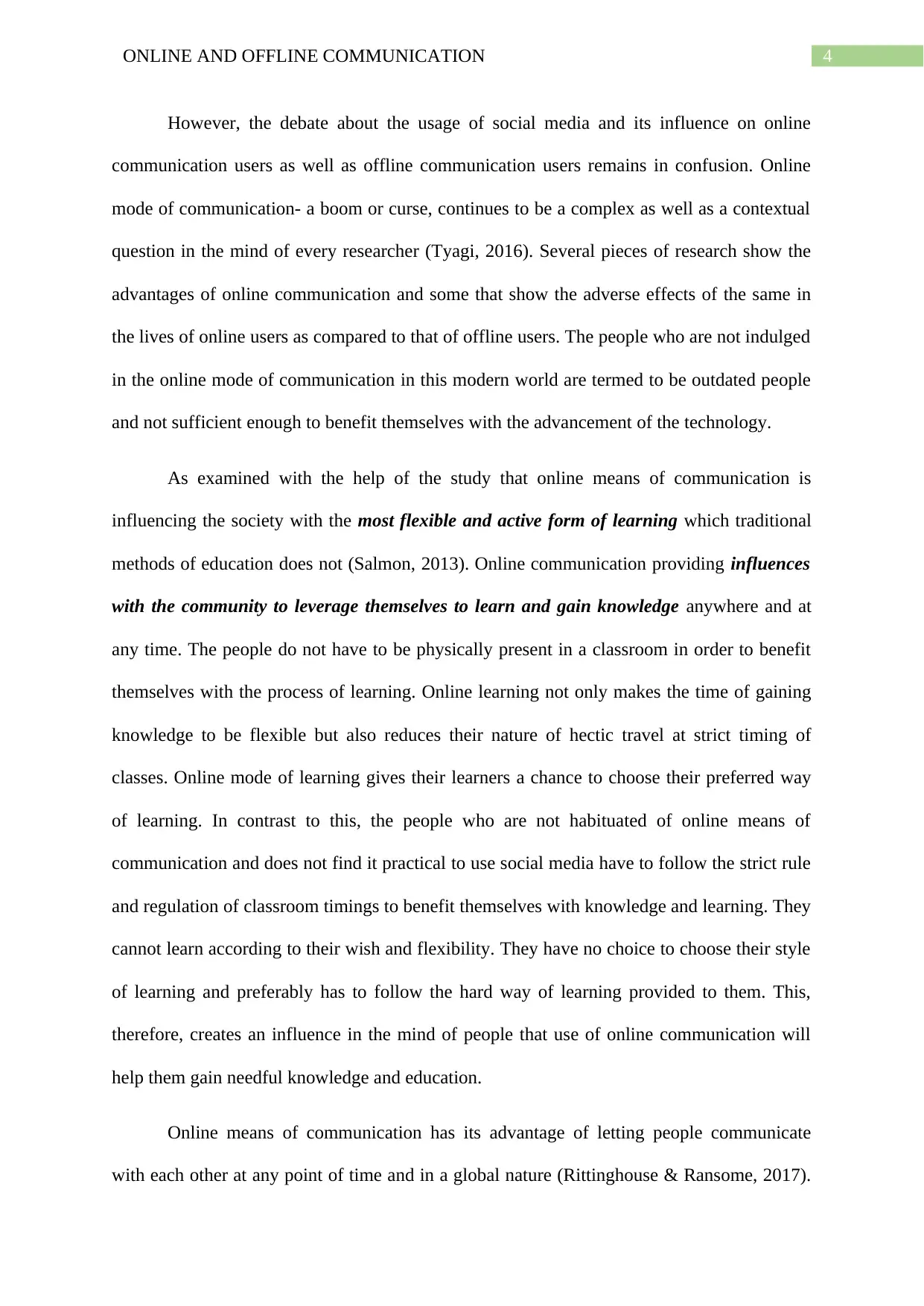
4ONLINE AND OFFLINE COMMUNICATION
However, the debate about the usage of social media and its influence on online
communication users as well as offline communication users remains in confusion. Online
mode of communication- a boom or curse, continues to be a complex as well as a contextual
question in the mind of every researcher (Tyagi, 2016). Several pieces of research show the
advantages of online communication and some that show the adverse effects of the same in
the lives of online users as compared to that of offline users. The people who are not indulged
in the online mode of communication in this modern world are termed to be outdated people
and not sufficient enough to benefit themselves with the advancement of the technology.
As examined with the help of the study that online means of communication is
influencing the society with the most flexible and active form of learning which traditional
methods of education does not (Salmon, 2013). Online communication providing influences
with the community to leverage themselves to learn and gain knowledge anywhere and at
any time. The people do not have to be physically present in a classroom in order to benefit
themselves with the process of learning. Online learning not only makes the time of gaining
knowledge to be flexible but also reduces their nature of hectic travel at strict timing of
classes. Online mode of learning gives their learners a chance to choose their preferred way
of learning. In contrast to this, the people who are not habituated of online means of
communication and does not find it practical to use social media have to follow the strict rule
and regulation of classroom timings to benefit themselves with knowledge and learning. They
cannot learn according to their wish and flexibility. They have no choice to choose their style
of learning and preferably has to follow the hard way of learning provided to them. This,
therefore, creates an influence in the mind of people that use of online communication will
help them gain needful knowledge and education.
Online means of communication has its advantage of letting people communicate
with each other at any point of time and in a global nature (Rittinghouse & Ransome, 2017).
However, the debate about the usage of social media and its influence on online
communication users as well as offline communication users remains in confusion. Online
mode of communication- a boom or curse, continues to be a complex as well as a contextual
question in the mind of every researcher (Tyagi, 2016). Several pieces of research show the
advantages of online communication and some that show the adverse effects of the same in
the lives of online users as compared to that of offline users. The people who are not indulged
in the online mode of communication in this modern world are termed to be outdated people
and not sufficient enough to benefit themselves with the advancement of the technology.
As examined with the help of the study that online means of communication is
influencing the society with the most flexible and active form of learning which traditional
methods of education does not (Salmon, 2013). Online communication providing influences
with the community to leverage themselves to learn and gain knowledge anywhere and at
any time. The people do not have to be physically present in a classroom in order to benefit
themselves with the process of learning. Online learning not only makes the time of gaining
knowledge to be flexible but also reduces their nature of hectic travel at strict timing of
classes. Online mode of learning gives their learners a chance to choose their preferred way
of learning. In contrast to this, the people who are not habituated of online means of
communication and does not find it practical to use social media have to follow the strict rule
and regulation of classroom timings to benefit themselves with knowledge and learning. They
cannot learn according to their wish and flexibility. They have no choice to choose their style
of learning and preferably has to follow the hard way of learning provided to them. This,
therefore, creates an influence in the mind of people that use of online communication will
help them gain needful knowledge and education.
Online means of communication has its advantage of letting people communicate
with each other at any point of time and in a global nature (Rittinghouse & Ransome, 2017).
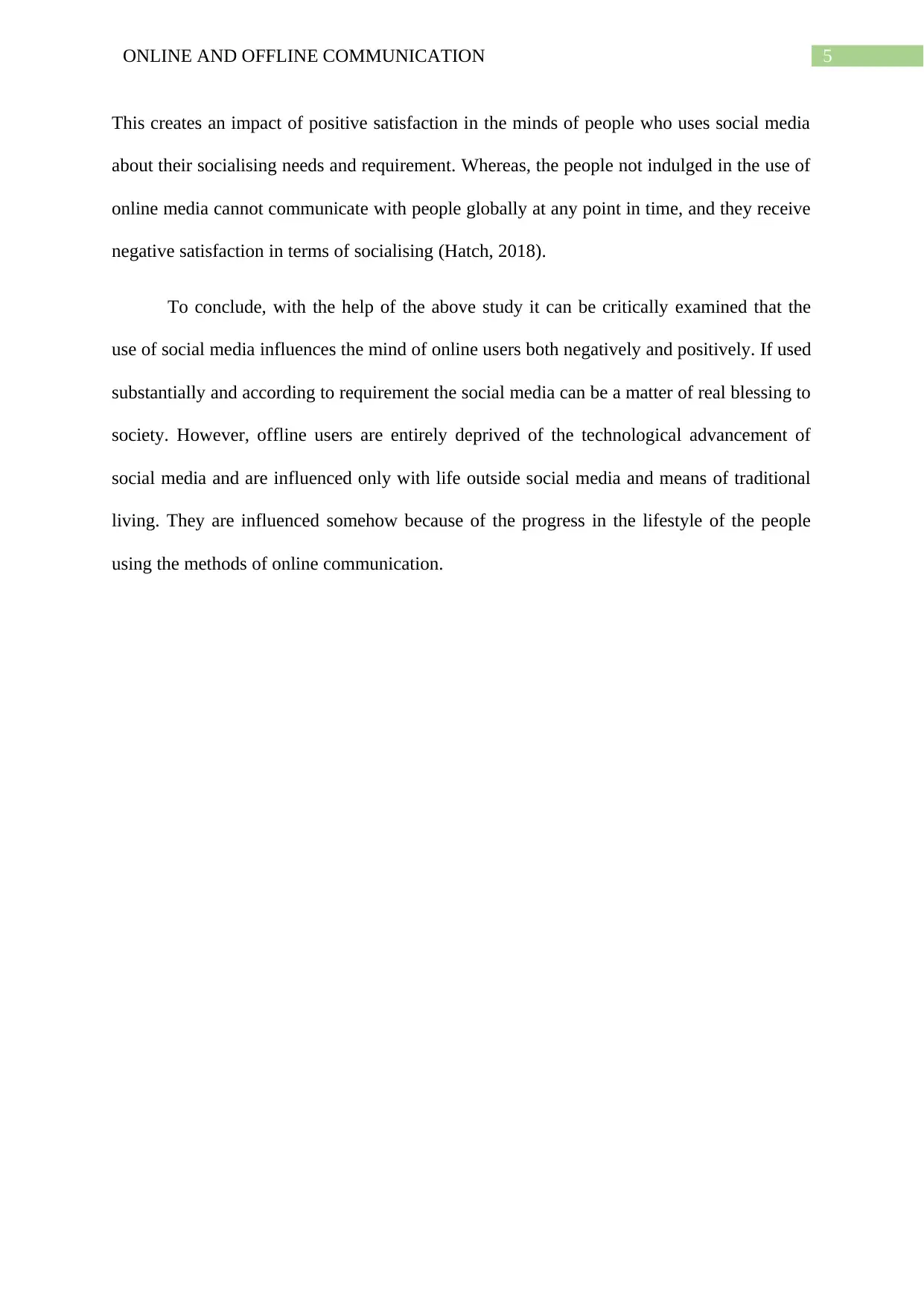
5ONLINE AND OFFLINE COMMUNICATION
This creates an impact of positive satisfaction in the minds of people who uses social media
about their socialising needs and requirement. Whereas, the people not indulged in the use of
online media cannot communicate with people globally at any point in time, and they receive
negative satisfaction in terms of socialising (Hatch, 2018).
To conclude, with the help of the above study it can be critically examined that the
use of social media influences the mind of online users both negatively and positively. If used
substantially and according to requirement the social media can be a matter of real blessing to
society. However, offline users are entirely deprived of the technological advancement of
social media and are influenced only with life outside social media and means of traditional
living. They are influenced somehow because of the progress in the lifestyle of the people
using the methods of online communication.
This creates an impact of positive satisfaction in the minds of people who uses social media
about their socialising needs and requirement. Whereas, the people not indulged in the use of
online media cannot communicate with people globally at any point in time, and they receive
negative satisfaction in terms of socialising (Hatch, 2018).
To conclude, with the help of the above study it can be critically examined that the
use of social media influences the mind of online users both negatively and positively. If used
substantially and according to requirement the social media can be a matter of real blessing to
society. However, offline users are entirely deprived of the technological advancement of
social media and are influenced only with life outside social media and means of traditional
living. They are influenced somehow because of the progress in the lifestyle of the people
using the methods of online communication.
⊘ This is a preview!⊘
Do you want full access?
Subscribe today to unlock all pages.

Trusted by 1+ million students worldwide
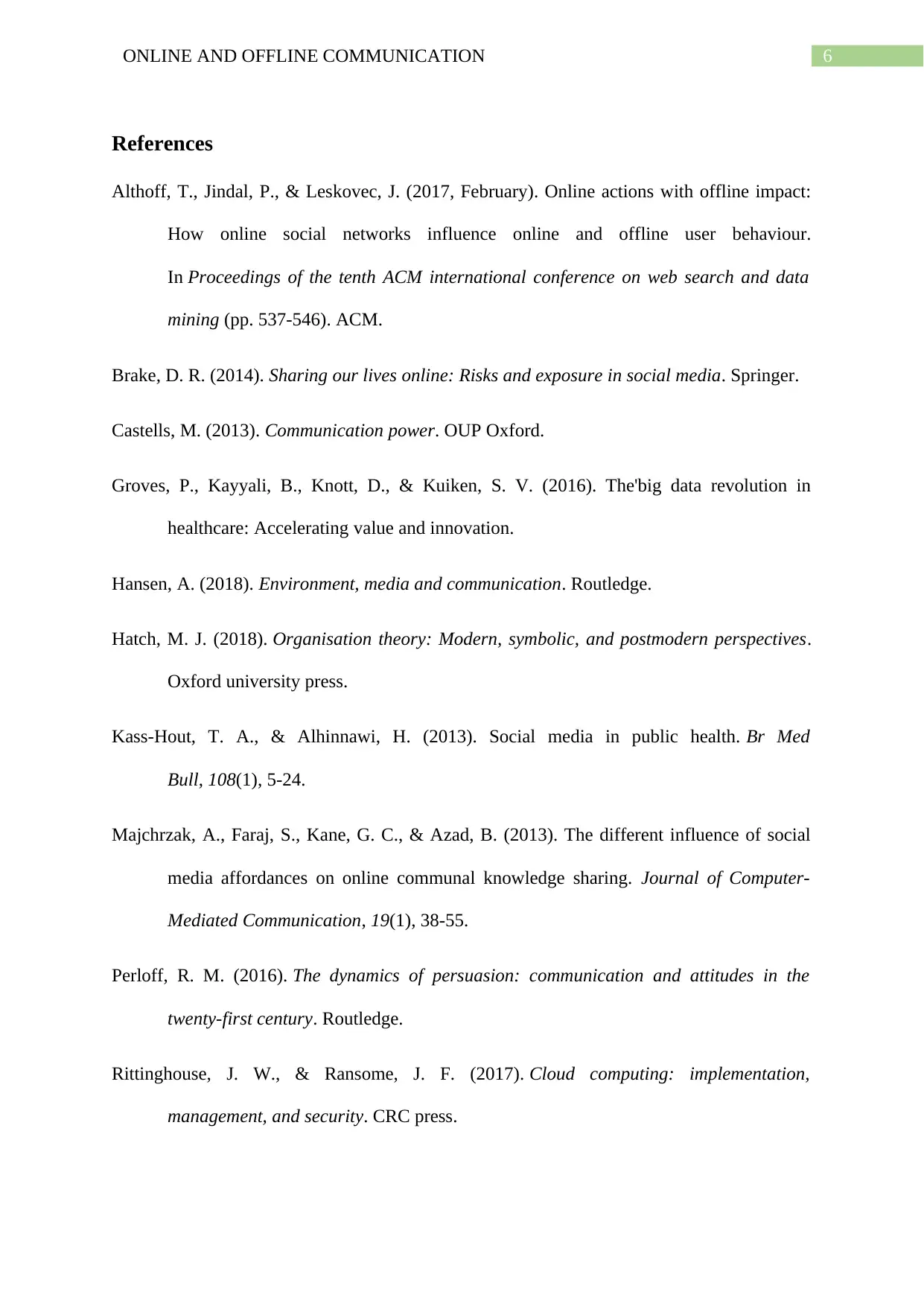
6ONLINE AND OFFLINE COMMUNICATION
References
Althoff, T., Jindal, P., & Leskovec, J. (2017, February). Online actions with offline impact:
How online social networks influence online and offline user behaviour.
In Proceedings of the tenth ACM international conference on web search and data
mining (pp. 537-546). ACM.
Brake, D. R. (2014). Sharing our lives online: Risks and exposure in social media. Springer.
Castells, M. (2013). Communication power. OUP Oxford.
Groves, P., Kayyali, B., Knott, D., & Kuiken, S. V. (2016). The'big data revolution in
healthcare: Accelerating value and innovation.
Hansen, A. (2018). Environment, media and communication. Routledge.
Hatch, M. J. (2018). Organisation theory: Modern, symbolic, and postmodern perspectives.
Oxford university press.
Kass-Hout, T. A., & Alhinnawi, H. (2013). Social media in public health. Br Med
Bull, 108(1), 5-24.
Majchrzak, A., Faraj, S., Kane, G. C., & Azad, B. (2013). The different influence of social
media affordances on online communal knowledge sharing. Journal of Computer-
Mediated Communication, 19(1), 38-55.
Perloff, R. M. (2016). The dynamics of persuasion: communication and attitudes in the
twenty-first century. Routledge.
Rittinghouse, J. W., & Ransome, J. F. (2017). Cloud computing: implementation,
management, and security. CRC press.
References
Althoff, T., Jindal, P., & Leskovec, J. (2017, February). Online actions with offline impact:
How online social networks influence online and offline user behaviour.
In Proceedings of the tenth ACM international conference on web search and data
mining (pp. 537-546). ACM.
Brake, D. R. (2014). Sharing our lives online: Risks and exposure in social media. Springer.
Castells, M. (2013). Communication power. OUP Oxford.
Groves, P., Kayyali, B., Knott, D., & Kuiken, S. V. (2016). The'big data revolution in
healthcare: Accelerating value and innovation.
Hansen, A. (2018). Environment, media and communication. Routledge.
Hatch, M. J. (2018). Organisation theory: Modern, symbolic, and postmodern perspectives.
Oxford university press.
Kass-Hout, T. A., & Alhinnawi, H. (2013). Social media in public health. Br Med
Bull, 108(1), 5-24.
Majchrzak, A., Faraj, S., Kane, G. C., & Azad, B. (2013). The different influence of social
media affordances on online communal knowledge sharing. Journal of Computer-
Mediated Communication, 19(1), 38-55.
Perloff, R. M. (2016). The dynamics of persuasion: communication and attitudes in the
twenty-first century. Routledge.
Rittinghouse, J. W., & Ransome, J. F. (2017). Cloud computing: implementation,
management, and security. CRC press.
Paraphrase This Document
Need a fresh take? Get an instant paraphrase of this document with our AI Paraphraser
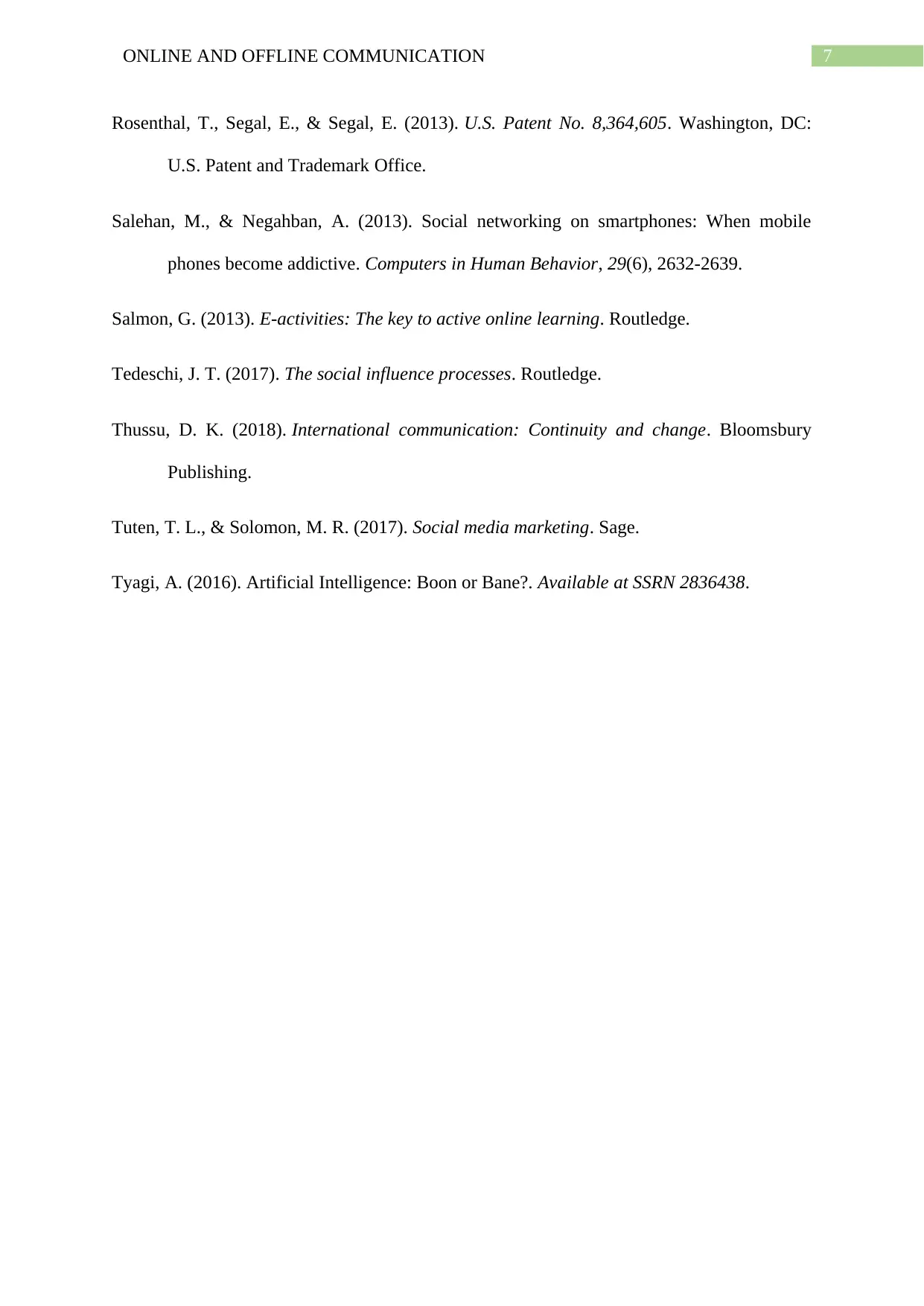
7ONLINE AND OFFLINE COMMUNICATION
Rosenthal, T., Segal, E., & Segal, E. (2013). U.S. Patent No. 8,364,605. Washington, DC:
U.S. Patent and Trademark Office.
Salehan, M., & Negahban, A. (2013). Social networking on smartphones: When mobile
phones become addictive. Computers in Human Behavior, 29(6), 2632-2639.
Salmon, G. (2013). E-activities: The key to active online learning. Routledge.
Tedeschi, J. T. (2017). The social influence processes. Routledge.
Thussu, D. K. (2018). International communication: Continuity and change. Bloomsbury
Publishing.
Tuten, T. L., & Solomon, M. R. (2017). Social media marketing. Sage.
Tyagi, A. (2016). Artificial Intelligence: Boon or Bane?. Available at SSRN 2836438.
Rosenthal, T., Segal, E., & Segal, E. (2013). U.S. Patent No. 8,364,605. Washington, DC:
U.S. Patent and Trademark Office.
Salehan, M., & Negahban, A. (2013). Social networking on smartphones: When mobile
phones become addictive. Computers in Human Behavior, 29(6), 2632-2639.
Salmon, G. (2013). E-activities: The key to active online learning. Routledge.
Tedeschi, J. T. (2017). The social influence processes. Routledge.
Thussu, D. K. (2018). International communication: Continuity and change. Bloomsbury
Publishing.
Tuten, T. L., & Solomon, M. R. (2017). Social media marketing. Sage.
Tyagi, A. (2016). Artificial Intelligence: Boon or Bane?. Available at SSRN 2836438.
1 out of 8
Related Documents
Your All-in-One AI-Powered Toolkit for Academic Success.
+13062052269
info@desklib.com
Available 24*7 on WhatsApp / Email
![[object Object]](/_next/static/media/star-bottom.7253800d.svg)
Unlock your academic potential
Copyright © 2020–2025 A2Z Services. All Rights Reserved. Developed and managed by ZUCOL.




